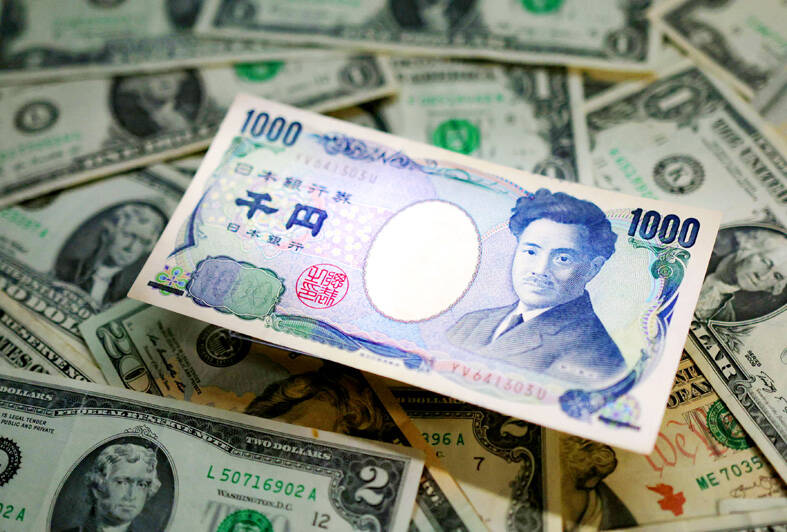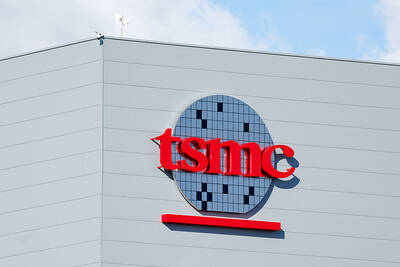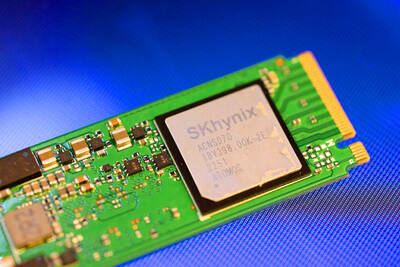The US dollar weakened on Friday after US labor data for last month showed slower wage growth, suggesting that an easing of inflation pressures might keep the US Federal Reserve’s pace of interest rate hikes modest and thereby reduce the greenback’s appeal.
The US economy last month added jobs at a brisk pace, but slower wage growth and a rise in the unemployment rate prompted financial markets to dial back expectations of a 50 basis point rate hike when Fed policymakers meet in two weeks.
Congressional testimony earlier in the week by Fed Chairman Jerome Powell was seen as hawkish and strengthened the US dollar as US Treasuries pay more in yield than other government debt.

Photo: Reuters
The US dollar slid against all major currencies, but was essentially flat against the Canadian dollar. The US dollar index, a basket of trading currencies, fell 0.64 percent to 104.64, but rose 0.11 percent from a week earlier.
Adding to the plunge in Treasury yields was the closing of SVB Financial Group, the largest bank failure since the financial crisis, as California regulators moved quickly to protect depositors at the lender.
The yield on benchmark 10-year Treasury notes fell more than 22 basis points to below 3.7 percent in the biggest single-day drop in four months. Bond yields move opposite to their price.
“There is a significant, in my opinion anyway, safe-haven bid going on,” WisdomTree head of fixed income Kevin Flanagan said. “There are concerns about potential banking stress.”
Average hourly earnings for all private workers rose 0.2 percent versus 0.3 percent in January, and lifted the year-on-year figure to 4.6 percent. Economists expected hourly earnings to rise 0.3 percent last month, which would have raised wages by 4.7 percent annually.
The US dollar might be range-bound as slowing inflation to the Fed’s target of 2 percent is likely to be bumpy, said Joe Manimbo, senior market analyst at Convera in Washington.
“When the market revises up expectations for peak rates, we see the dollar take two steps up, but once the dust settles, we see the dollar take a step back,” Manimbo said. “The market already anticipates that the Fed is going to pause this year, but exactly when it’s just unknown.”
The New Taiwan dollar shrank against the US dollar on Friday, losing NT$0.038 to close at NT$30.848, down 0.72 percent from NT$30.627 a week earlier.
The Japanese yen rose 1.15 percent to ¥135 per US dollar.
The US dollar earlier jumped against the yen in a knee-jerk move after the Bank of Japan (BOJ) kept policy unchanged in BOJ Governor Haruhiko Kuroda’s last policy meeting before he steps down in April.
While the decision was expected by most market watchers, many see the days of the BOJ’s bond yield curve control as numbered, which led to some pricing in a slim chance of a policy tweak at Kuroda’s last policy meeting.
Additional reporting by CNA, with staff writer

On Tuesday, US President Donald Trump weighed in on a pressing national issue: The rebranding of a restaurant chain. Last week, Cracker Barrel, a Tennessee company whose nationwide locations lean heavily on a cozy, old-timey aesthetic — “rocking chairs on the porch, a warm fire in the hearth, peg games on the table” — announced it was updating its logo. Uncle Herschel, the man who once appeared next to the letters with a barrel, was gone. It sparked ire on the right, with Donald Trump Jr leading a charge against the rebranding: “WTF is wrong with Cracker Barrel?!” Later, Trump Sr weighed

Taiwan Semiconductor Manufacturing Co (TSMC, 台積電) secured a record 70.2 percent share of the global foundry business in the second quarter, up from 67.6 percent the previous quarter, and continued widening its lead over second-placed Samsung Electronics Co, TrendForce Corp (集邦科技) said on Monday. TSMC posted US$30.24 billion in sales in the April-to-June period, up 18.5 percent from the previous quarter, driven by major smartphone customers entering their ramp-up cycle and robust demand for artificial intelligence chips, laptops and PCs, which boosted wafer shipments and average selling prices, TrendForce said in a report. Samsung’s sales also grew in the second quarter, up

HEADWINDS: Upfront investment is unavoidable in the merger, but cost savings would materialize over time, TS Financial Holding Co president Welch Lin said TS Financial Holding Co (台新新光金控) said it would take about two years before the benefits of its merger with Shin Kong Financial Holding Co (新光金控) become evident, as the group prioritizes the consolidation of its major subsidiaries. “The group’s priority is to complete the consolidation of different subsidiaries,” Welch Lin (林維俊), president of the nation’s fourth-largest financial conglomerate by assets, told reporters during its first earnings briefing since the merger took effect on July 24. The asset management units are scheduled to merge in November, followed by life insurance in January next year and securities operations in April, Lin said. Banking integration,

LOOPHOLES: The move is to end a break that was aiding foreign producers without any similar benefit for US manufacturers, the US Department of Commerce said US President Donald Trump’s administration would make it harder for Samsung Electronics Co and SK Hynix Inc to ship critical equipment to their chipmaking operations in China, dealing a potential blow to the companies’ production in the world’s largest semiconductor market. The US Department of Commerce in a notice published on Friday said that it was revoking waivers for Samsung and SK Hynix to use US technologies in their Chinese operations. The companies had been operating in China under regulations that allow them to import chipmaking equipment without applying for a new license each time. The move would revise what is known